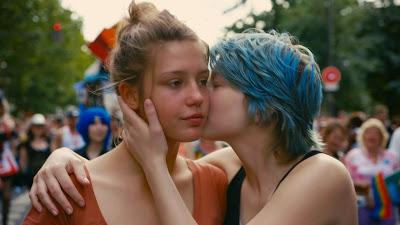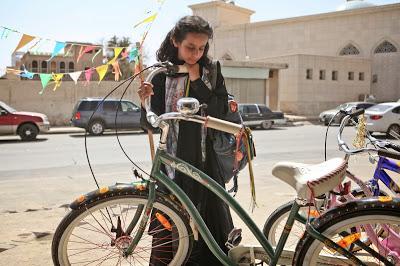Format: Streaming video from NetFlix (Blue) and DVD from NetFlix (Wadjda) on laptop.

I’ve lost track of the number of times on this blog that I’ve talked about the way that coming-of-age films work. Typically, a coming of age story for boys involves coming to grips with mortality. Boys, at least in a serious coming-of-age tale, need to confront death. For girls (and for boys in comedies), coming-of-age stories are about sex. Girls need to come to terms with their ability to create life. This is one of the reasons I’ve put off watching La Vie d’Adele—Chapitres 1 & 2 (much more commonly known as Blue is the Warmest Color) for as long as I have. Why else? Well, it’s three hours long, and I’m not always down for that.
Blue is the Warmest Color is not really about that, though. Oh, don’t misunderstand—this is very much a girl’s coming-of-age story and it doesn’t skimp on the sex. So, while the film is very much about sex, it’s far more about sexual identity and personal identity than it is purely about sex. I do feel like I need to throw a warning out there, though; this film is rated NC-17 for a reason, and the bulk of that reason is about 15 combined minutes of sex. This isn’t movie sex—it’s sex. If they faked it, I have no idea how they did it. Honestly, I think they did it by not faking it.
Anyway, Adele (Adele Exarchopoulos) is at first glance a fairly typical 17-year-old finishing up high school. Her various friends appear to be obsessed with boys and with sex in particular. Aware that a boy in school appears to be attracted to her, Adele dates him briefly, but discovers that while sex is at least interesting, it’s not particularly satisfying. This occurs simultaneously with Adele spotting a young woman with blue hair on the street. She is immediately attracted to her, causing Adele to question her own sexual identity.
Eventually, Adele’s openly gay friend Valentin (Sandor Funtek) takes her to a gay bar. Adele wanders off and winds up in a lesbian bar, where she encounters a number of aggressive advances from the other patrons. Who comes to rescue her but the woman with the blue hair. Thus starts the relationship between Adele and Emma (Lea Seydoux). It begins in secret, in no small part because Adele’s friends begin accusing her of being a lesbian. While Emma’s parents seem to be fine with their daughter’s sexuality, Adele is forced to tell her own parents that Emma is her philosophy tutor.
Jump ahead several years and the two are now living together. Adele poses for Emma’s paintings and finds her life as a kindergarten teacher rewarding. But her home life is not so fulfilled. When Emma has a show of her work, Adele discovers that she feels intellectually left behind both Emma and all of Emma’s friends. Frustrated, confused, and lonely, Adele eventually sleeps with a male colleague, which spells the beginning of the end of her relationship with Emma.
There’s more, of course. Those paragraphs are simply the broadest strokes of a film that spins for three hours. The entire point of the film is not specifically Adele’s relationship with Emma, but Adele’s relationship with her own confused sexual identity and with herself. She is content with her teaching job, but it’s evident that Emma wants her to become more. Adele constantly feels out of her depth around Emma’s friends, which seems to work as a metaphor for her being similarly at sea with her own desires and sexual identity.
I mentioned the sex above, but it deserves a longer treatment. It’s these scenes that will be longest remembered by most viewers not because they depict sex, but because they depict what looks for all the world like peeking into someone’s bedroom. All told, there’s about 15 minutes of sex in the film, about half of which comes in a single scene. Director Abdellatif Kechiche enhances this feeling by having no non-diegetic music in these scenes (or the film, for that matter).
What this leads me to is an important question—why do I accept the sex in this film while I objected so strongly to it in a film like In the Realm of the Senses? It’s a fair question and one that deserves a serious answer. There are a couple of reasons for this. First, while both films contain either explicit sex or what looks to be explicit sex, In the Realm of the Senses is about little else. It’s not exploring anything; it’s just depicting two people going at it like rabbits. The sex in that film encompasses what feels like the entire running time. Here, it’s merely a part of the whole.
So the next question is this: what would the film lose if the sex was cut? It’s another fair question, and I think it could be argued that even though it’s a small percentage of the running time that it overshadows everything else in Blue is the Warmest Color. But I think we need to see the passion. I think we need to understand the depth and intensity of the feelings Adele experiences, and there’s no way to do that without showing us something of whare that comes from. It might not all be needed, but some of it definitely is.
But is it good? Yeah, it is. It’s worth watching, but know for a fact that your spouse, your kids, or your parents will walk in at the most inappropriate time.

Wadjda explores very little about sexuality, spending its time more fully on the idea of gender and gender roles. That might seem like a dry subject, but since we’re dealing with those questions in Saudi Arabia, they are important. I know very little about laws and customs in the Islamic world. I know from films like Osama that there are parts of the Muslim world in which women are virtual prisoners to the local religious ideology and tradition.
Wadjda (pronounced like it’s spelled with the first "d” silent, and played by Waad Mohammed> is a young Saudi girl who spends her days in a madrassa being educated both in traditional subjects and in the Qur’an. What she really wants more than anything, though, is a bicycle. She becomes enamored of the bike ridden by her friend Abdullah (Abdullrahman Al Gohani) and wants one for herself, specifically because she dreams of beating Abdullah in a race.
And here’s where the culture becomes important. She is told over and over again by her mother (Reem Abdullah) and by the principal of her school (Ahd) that girls don’t ride bikes. More specifically, she is told that if she rides a bike she will not be able to have children.
A great deal of what happens here is not specifically about Wadjda wanting a bike, but about her dealing with a culture and a society that devalues women, and thus devalues her. I mentioned above that there is less here about sexuality than in Blue is the Warmest Color, but I’m not sure that’s entirely true. The Saudi culture, at least as depicted here, feels obsessed with sexuality and the sexualization of virtually everything. Girls playing outside of their school are forced to go inside if men at a nearby construction site can see them. For me, the immediate question is what sort of men would become sexually aroused watching 12-year-olds play hopscotch?
Wadjda’s desire for a bicycle seems to be a symbol of her larger desire to, in many ways, be free of the culture that keeps her locked behind a hijab, unable to ever drive herself anywhere, unable to be unaccompanied in the presence of men not her husband or, once she is old enough, to even walk outside without covering her face.
Another significant culture clash here is the situation of Wadjda’s parents. Her father (Sultan Al Assaf) is rarely home, choosing to spend most of his time away from his family. Wadjda’s mother is convinced (and eventually proved correct) that he is looking for a second wife because he wants a son that she cannot give him, having almost died giving birth to Wadjda.
It’s these cultural differences that make Wadjda so fascinating. Without them, this is simply the story of a young girl who wants something she’s not supposed to have and struggling against all of the people who tell her that she shouldn’t have it. Because this desire is overtopped by both culture and religion (or, more accurately, religion expressing itself through culture), Wadjda’s desires seem completely hopeless. Where Adele in Blue is the Warmest Color has the freedom to express her desires but doesn’t really know how, Wadjda knows exactly what she wants and is actively prevented from pursuing it.
Wadjda is the first all-Saudi film production and the first from its director, Haifaa Al-Mansour. It’s noteworthy, I think, that the director of this film is a woman expressing some of the frustrations of living in a repressive culture in the current century. Allegedly, there were many scenes that she was forced to direct from a distance over walkie-talkie, since she could not be in the presence of men in the crew. I can only imagine what that must have been like—to have something to say and to so frequently have impediments thrown up against it. In other words, the creation of the film itself has a great deal in common with its title character.
Speaking of her, Waad Mohammed is an absolute natural in front of the camera. I would guess that this is her first film, and she does not look like she is acting at all. She looks for all the world like a typical 12-year-old kid experiencing growing pains. The part of me that hates to see repression of anyone and anything hopes that she somehow gets out of that culture because I’d love to see her have a career. She definitely has the talent. She’s immensely likable on screen, the kind of person that is incredibly easy to root for. Part of that is the character, certainly, but a great deal of that comes from Waad Mohammed.
All told, Wadjda is a story that you’ve seen before. There’s not that much new here and not much that’s going to come across as new or innovative. That’s okay. It’s great to see the birth of a new national cinema. While Wadjda may be baby steps in terms of plot, pacing, and story, it’s a giant leap for what it might actually mean in the grander scheme of things.
Why to watch Blue is the Warmest Color: A standard coming-of-age story that is anything but standard.
Why not to watch: Your kids, your parents, and/or your spouse will absolutely walk in at the wrong time.
Why to watch Wadjda: A familiar story in very unfamiliar clothing.
Why not to watch: It’s not hard to figure out where it’s going.
